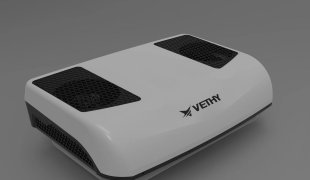The Future of 12V Parking Air Conditioning: Solar Power and Smart Climate Control
March 25, 2025
I. Introduction
The rapid evolution of vehicle auxiliary systems has positioned 12V parking air conditioning at the forefront of sustainable innovation. As global temperatures rise and emission regulations tighten, industries from logistics to recreational travel demand solutions that balance efficiency with environmental responsibility. By 2030, solar energy integration and AI-driven climate control will redefine how vehicles manage temperature, transforming parking AC from a power-draining necessity to a cornerstone of smart, eco-conscious design. This article explores emerging technologies, economic implications, and the pivotal role of user experience in shaping this transition.
(Internal link: vethy.com/sustainable-transportation-trends)
II. Cutting-Edge Solar Technologies Reshaping the Market
1. Ultra-Thin Photovoltaic Films: A Game Changer
Traditional rigid solar panels are being eclipsed by lightweight, flexible films. Companies like MiaSolé now produce panels as thin as 1mm, achieving 28% efficiency under optimal conditions. These films adhere seamlessly to curved vehicle surfaces, such as truck trailers or RV roofs, without compromising aerodynamics. For instance, Tesla’s Semi Trucks now integrate these films to power auxiliary systems, reducing grid dependency by 40%.
Key Innovations:
Perovskite Solar Cells: Lower production costs and higher low-light efficiency.
Transparent Solar Glass: Applied to windows, doubling as tinting and energy harvesters.
(External link: MiaSolé Flexible Solar)
(Internal link: vethy.com/solar-film-tech)
2. Hybrid Energy Systems: Beyond 48V Architecture
While 48V systems dominate today, 2026 will see the rise of 72V platforms. These systems, paired with advanced MPPT controllers, support higher power loads for multi-zone cooling. A pilot project by Volvo Trucks demonstrated a 72V solar-hybrid AC cooling three compartments simultaneously, cutting idle time by 55% in refrigerated transport.
(External link: Volvo Trucks Sustainability)
III. AI and Machine Learning: The Brains Behind Efficiency
1. Predictive Climate Algorithms
AI models now analyze terabytes of data—from historical weather patterns to driver behavior—to optimize energy use. For example, Panasonic’s Smart Cabin System pre-cools vehicles during off-peak solar hours, reducing midday load spikes by 30%. These algorithms also adjust airflow based on occupancy, ensuring no energy is wasted on empty seats.
Applications:
Fleet Management: AI coordinates cooling schedules across hundreds of vehicles to avoid grid overload.
Battery Health Monitoring: Machine learning predicts lithium battery degradation, suggesting maintenance before failures occur.
(Internal link: vethy.com/ai-fleet-solutions)
2. Natural Language Processing (NLP) for User Interaction
Voice-activated controls, powered by NLP, are becoming standard. Drivers can command systems like, “Lower cabin temperature to 20°C using solar priority,” streamlining operations without manual input. Startups like EcoTalk are integrating these features with multilingual support, critical for global logistics.
(External link: EcoTalk Voice Control)
IV. Regulatory Landscapes and Global Adoption
1. Policy Drivers Accelerating Solar Integration
Governments are incentivizing solar adoption through tax breaks and mandates:
EU’s Solar Mobility Initiative (2026): Requires all new commercial vehicles to include solar-ready AC systems by 2028.
California’s Zero-Emission Parking (ZEP) Regulation: Grants subsidies for fleets retrofitting solar AC, aiming for 50% adoption by 2027.
*(External link: EU Solar Mobility Policy)
2. Emerging Markets: Asia and Africa
Countries like India and Kenya are leapfrogging traditional infrastructure. Solar-powered ACs in buses and ambulances address both cooling needs and power instability. Mahindra Electric’s solar buses in Mumbai, for example, use rooftop panels to run ACs continuously, even during monsoons.
(Internal link: vethy.com/emerging-markets)
V. Overcoming Barriers: Cost, Durability, and Public Perception
1. Cost Reduction Through Circular Manufacturing
Recycling lithium batteries and solar cells is slashing prices. Redwood Materials now recovers 95% of battery materials, cutting production costs by 25%. Similarly, First Solar’s panel recycling plants reduce waste, making systems accessible to budget-conscious buyers.
*(External link: Redwood Materials Recycling)
2. Combatting “Solar Skepticism”
Misconceptions about solar reliability persist. Brands counter this with real-world data:
Durability Tests: Panels withstand hail impacts at 100 km/h (per IEC 61215 standards).
Performance Guarantees: 25-year warranties on solar output (e.g., LG Solar).
(Internal link: vethy.com/solar-myths)
VI. User-Centric Innovations Driving Adoption
1. Modular Design for Customization
Systems like vethy.com ’s SolarFlex Pro allow users to mix and match components. A delivery van might add extra panels for refrigeration, while an RV prioritizes battery storage for overnight cooling.
*(Internal link: vethy.com/solarflex-pro)
2. Gamification of Energy Savings
Apps now turn energy efficiency into interactive experiences. Siemens’ EcoDrive rewards drivers with badges for minimizing grid usage, fostering competition among fleets.
*(External link: Siemens EcoDrive)
VII. The Road to 2030: Five Predictions
Solar Dominance: 70% of new commercial vehicles will have solar-integrated AC by 2030.
AI Standardization: Predictive climate controls will become as ubiquitous as GPS.
V2G Integration: Vehicles will supply excess solar energy to homes during blackouts.
Material Breakthroughs: Graphene-based solar cells will push efficiencies above 40%.
Global Equity: Affordable solar AC kits will revolutionize cooling in developing nations.
VIII. Conclusion
The future of 12V parking AC lies at the intersection of sustainability and intelligence. Solar power and AI are not mere upgrades—they are redefining how vehicles interact with energy ecosystems. For businesses, early adoption promises competitive advantage; for consumers, it’s a step toward affordable, guilt-free comfort. As the industry evolves, vethy.com remains committed to delivering cutting-edge solutions that prioritize both planetary health and user satisfaction.
Explore our latest solar AC innovations here:
(Internal link: vethy.com/solar-ac)





